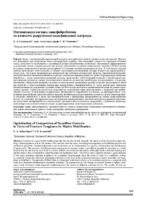Оптимизация состава нанофибробетона по вязкости разрушения модификацией матрицы

Date
2022Publisher
Another Title
Optimization of Composition of Nanofiber Concrete in Terms of Fracture Toughness by Matrix Modifiсation
Bibliographic entry
Садовская, Е. А. Оптимизация состава нанофибробетона по вязкости разрушения модификацией матрицы = Optimization of Composition of Nanofiber Concrete in Terms of Fracture Toughness by Matrix Modifiсation / Е. А. Садовская, С. Н. Леонович // Наука и техника. – 2022. – № 6. – С. 499-503.
Abstract
Бетон – квазихрупкий строительный материал, который имеет низкую прочность при растяжении. Процесс его разрушения при нагружении носит неоднородный характер, обусловленный сущностью структуры бетонной массы, состоящей из компонентов с различными физико-механическими свойствами. Постепенное деформирование и разрушение можно охарактеризовать как процесс образования и развития микротрещин. Наличие в бетоне разных по размеру компонентов позволяет рассматривать его строение как многоуровневую систему. В этой системе каждый уровень представляет собой матрицу со своими структурными включениями, которые играют как структурообразующую роль, так и роль концентраторов напряжений при действии механических нагрузок. Критический коэффициент интенсивности напряжений является хорошим показателем трещиностойкости (вязкости разрушения) материала. Нанобетон, с точки зрения многоуровневой системы, представляет собой бетонный композит с ингибиторами распространения трещин на уровне цементирующего вещества (в качестве ингибиторов рассматриваются углеродные нанотрубки). Присутствие фибровых волокон на последующих масштабных уровнях позволяет рассматривать бетон как композит с многоуровневым дисперсным армированием (нанофибробетон). В статье рассмотрено изменение показателя вязкости разрушения (трещиностойкости) бетона при дисперсном армировании матрицы на разных структурных уровнях. Приведены результаты испытаний на нормальный отрыв образцов-кубов с надрезами при внецентренном сжатии с определением коэффициента интенсивности напряжений для бетона, модифицированного углеродными нанотрубками, выступающими в качестве ингибиторов распространения трещин на уровне цементирующего вещества (нанобетон), а также для нанофибробетонов с дисперсным армированием на уровне мелкозернистого бетона. На основании экспериментальных исследований неравновесными методами механики разрушения предложены композиции нанофибробетона максимальной трещиностойкости (вязкости разрушения) с различной концентрацией фибры и несколькими типами матриц, модифицированных наноуглеродными добавками.
Abstract in another language
Concrete is a quasi-brittle building material that has low tensile strength. The process of its destruction under loading is inhomogeneous, due to the nature of the concrete structure mass, consisting of components with different physical and mechanical properties. Gradual deformation and destruction can be characterized as a process of formation and development of microcracks. The presence of different-sized components in concrete makes it possible to consider its structure as a multilevel system. In this system, each level is a matrix with its own structural inclusions, which play both a structure-forming role and the role of stress concentrators under the action of mechanical loads. The critical stress intensity factor is a good indicator of the crack resistance (fracture toughness) of a material. Nanoconcrete, from the point of view of a multilevel system, is a concrete composite with crack propagation inhibitors at the level of the cementing substance (carbon nanotubes are considered as inhibitors). The presence of fiber fibers at subsequent scale levels allows us to consider concrete as a composite with multi-level dispersed reinforcement (nanofiber concrete). The paper discusses the change of concrete fracture toughness indicator (crack resistance) with dispersed reinforcement of the matrix at different structural levels. The results of tests are presented for normal separation of notched cubes under eccentric compression with the determination of the stress intensity factor for concrete modified with carbon nanotubes acting as crack propagation inhibitors at the level of cementing substance (nanoconcrete), as well as for nanofiber concrete with dispersed reinforcement at the level of fine-grained concrete. Based on experimental studies by non-equilibrium methods of fracture mechanics, compositions of nanofiber-reinforced concrete of maximum crack resistance (fracture toughness) with different fiber concentrations and several types of matrices modified with nanocarbon additives are proposed in the paper.
View/
Collections
- № 6[10]
